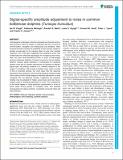Files in this item
Signal-specific amplitude adjustment to noise in common bottlenose dolphins (Tursiops truncatus)
Item metadata
| dc.contributor.author | Kragh, Ida M. | |
| dc.contributor.author | McHugh, Katherine | |
| dc.contributor.author | Wells, Randall S. | |
| dc.contributor.author | Sayigh, Laela S. | |
| dc.contributor.author | Janik, Vincent M. | |
| dc.contributor.author | Tyack, Peter L. | |
| dc.contributor.author | Jensen, Frants H. | |
| dc.date.accessioned | 2020-12-07T15:55:22Z | |
| dc.date.available | 2020-12-07T15:55:22Z | |
| dc.date.issued | 2019-12-03 | |
| dc.identifier | 264039426 | |
| dc.identifier | 8f1ea471-4d9e-4ff4-a339-4ecd72a35fad | |
| dc.identifier | 31704900 | |
| dc.identifier | 85075961341 | |
| dc.identifier | 000505202500026 | |
| dc.identifier.citation | Kragh , I M , McHugh , K , Wells , R S , Sayigh , L S , Janik , V M , Tyack , P L & Jensen , F H 2019 , ' Signal-specific amplitude adjustment to noise in common bottlenose dolphins ( Tursiops truncatus ) ' , Journal of Experimental Biology , vol. 222 , no. 23 , jeb216606 . https://doi.org/10.1242/jeb.216606 | en |
| dc.identifier.issn | 0022-0949 | |
| dc.identifier.other | Bibtex: Kraghjeb216606 | |
| dc.identifier.other | ORCID: /0000-0002-8409-4790/work/65702574 | |
| dc.identifier.other | ORCID: /0000-0001-7894-0121/work/65702679 | |
| dc.identifier.uri | https://hdl.handle.net/10023/21079 | |
| dc.description | Fieldwork in Sarasota was funded by the Grossman Foundation, the Office of Naval Research, and Woods Hole Oceanographic Institution. Health assessments were funded by Dolphin Quest, Inc. I.M.K. received support from the Danish Acoustical Society (Dansk Akustisk Selskab). P.L.T. received funding from the University of St Andrews, the Office of Naval Research (N00014-19-1-2560) and the MASTS pooling initiative (The Marine Alliance for Science and Technology for Scotland). F.H.J. was supported by the Office of Naval Research (N00014-1410410) and an AIAS-COFUND fellowship from Aarhus Institute of Advanced Studies under the FP7-PEOPLE programme of the EU (agreement no. 609033). All support is gratefully acknowledged. | en |
| dc.description.abstract | Anthropogenic underwater noise has increased over the past century, raising concern about the impact on cetaceans that rely on sound for communication, navigation and locating prey and predators. Many terrestrial animals increase the amplitude of their acoustic signals to partially compensate for the masking effect of noise (the Lombard response), but it has been suggested that cetaceans almost fully compensate with amplitude adjustments for increasing noise levels. Here, we used sound-recording DTAGs on pairs of free-ranging common bottlenose dolphins (Tursiops truncatus) to test (i) whether dolphins increase signal amplitude to compensate for increasing ambient noise and (ii) whether adjustments are identical for different signal types. We present evidence of a Lombard response in the range 0.1–0.3 dB per 1 dB increase in ambient noise, which is similar to that of terrestrial animals, but much lower than the response reported for other cetaceans. We found that signature whistles tended to be louder and with a lower degree of amplitude adjustment to noise compared with non-signature whistles, suggesting that signature whistles may be selected for higher output levels and may have a smaller scope for amplitude adjustment to noise. The consequence of the limited degree of vocal amplitude compensation is a loss of active space during periods of increased noise, with potential consequences for group cohesion, conspecific encounter rates and mate attraction. | |
| dc.format.extent | 11 | |
| dc.format.extent | 3758850 | |
| dc.language.iso | eng | |
| dc.relation.ispartof | Journal of Experimental Biology | en |
| dc.subject | Cetacean | en |
| dc.subject | Signature whistle | en |
| dc.subject | Communication | en |
| dc.subject | Anthropogenic noise | en |
| dc.subject | Masking | en |
| dc.subject | Lombard response | en |
| dc.subject | QH301 Biology | en |
| dc.subject | DAS | en |
| dc.subject.lcc | QH301 | en |
| dc.title | Signal-specific amplitude adjustment to noise in common bottlenose dolphins (Tursiops truncatus) | en |
| dc.type | Journal article | en |
| dc.contributor.institution | University of St Andrews. School of Biology | en |
| dc.contributor.institution | University of St Andrews. Sea Mammal Research Unit | en |
| dc.contributor.institution | University of St Andrews. Scottish Oceans Institute | en |
| dc.contributor.institution | University of St Andrews. Institute of Behavioural and Neural Sciences | en |
| dc.contributor.institution | University of St Andrews. Centre for Social Learning & Cognitive Evolution | en |
| dc.contributor.institution | University of St Andrews. Bioacoustics group | en |
| dc.contributor.institution | University of St Andrews. Marine Alliance for Science & Technology Scotland | en |
| dc.contributor.institution | University of St Andrews. Sound Tags Group | en |
| dc.identifier.doi | 10.1242/jeb.216606 | |
| dc.description.status | Peer reviewed | en |
| dc.date.embargoedUntil | 2020-12-03 |
This item appears in the following Collection(s)
Items in the St Andrews Research Repository are protected by copyright, with all rights reserved, unless otherwise indicated.

